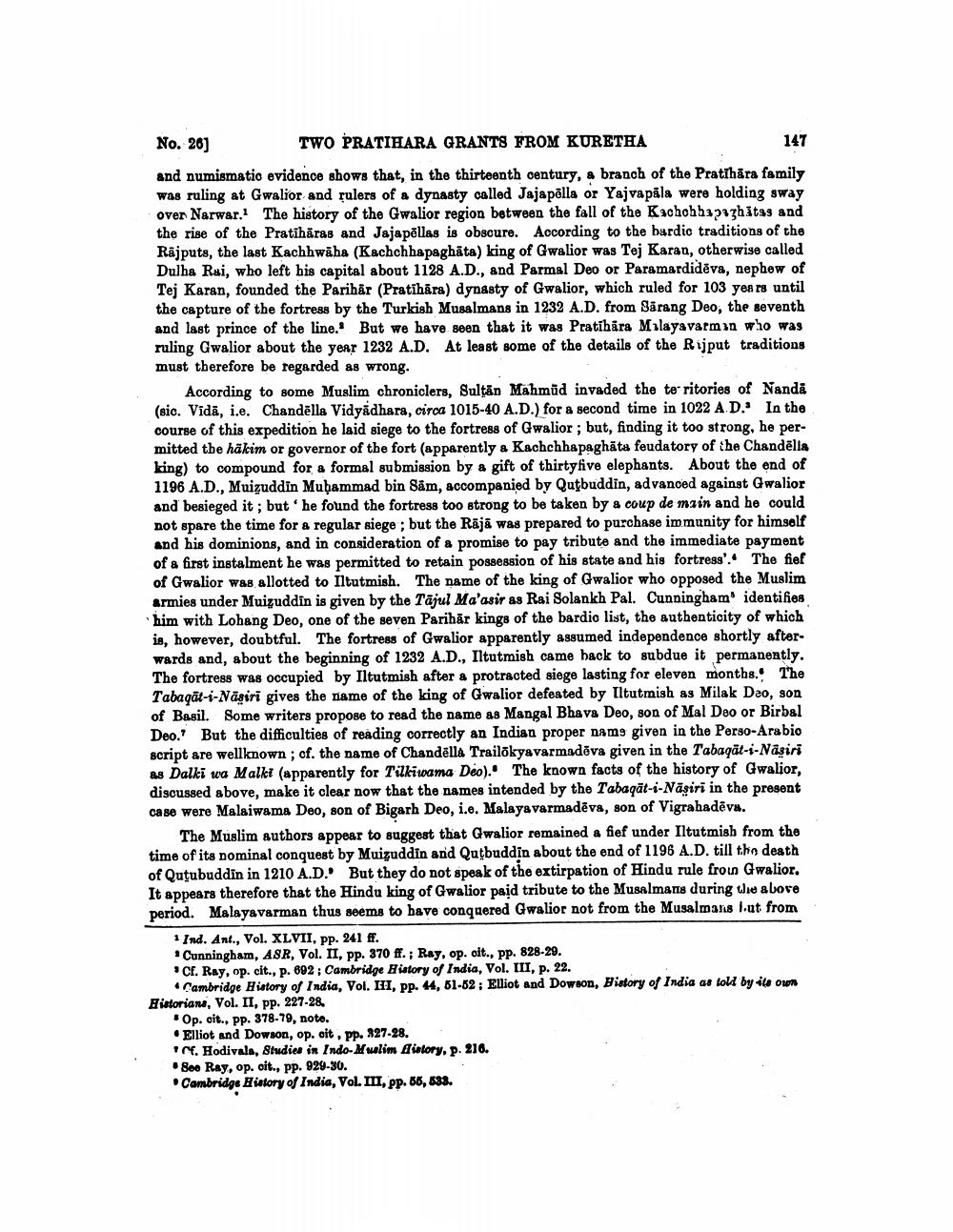________________
No. 26)
TWO PRATIHARA GRANTS FROM KURETHA
147
and numismatio evidence shows that, in the thirteenth century, a branch of the Pratīhāra family was ruling at Gwalior and rulers of a dynasty called Jajapõlla or Yajvapāla were holding sway over Narwar. The history of the Gwalior region between the fall of the Kachohhapuchatas and the rise of the Pratihäras and Jajapöllas is obscure. According to the bardio traditions of the Rājputs, the last Kachhwāha (Kachchhapaghāta) king of Gwalior was Tej Karan, otherwise called Dulha Rai, who left his capital about 1128 A.D., and Parmal Deo or Paramardidēva, nephew of Tej Karan, founded the Parihar (Pratīhāra) dynasty of Gwalior, which ruled for 103 years until the capture of the fortress by the Turkish Musalmans in 1232 A.D. from Sarang Deo, the seventh and last prince of the line. But we have seen that it was Pratihāra Malayavarman who was ruling Gwalior about the year 1232 A.D. At least some of the details of the Rijput traditions must therefore be regarded as wrong.
According to some Muslim chroniclers, Sultan Mahmud invaded the territories of Nanda (sic. Vidā, i.e. Chandella Vidyâdhara, circa 1015-40 A.D.) for a second time in 1022 A D. In the course of this expedition he laid siege to the fortress of Gwalior ; but, finding it too strong, he permitted the hâkim or governor of the fort (apparently a Kachchhapaghāta feudatory of the Chandēlia king) to compound for a formal submission by a gift of thirtyfive elephants. About the end of 1196 A.D., Muizuddin Muhammad bin Säm, accompanied by Qutbuddin, advanced against Gwalior and besieged it ; but he found the fortress too strong to be taken by a coup de main and he could not spare the time for a regular siege ; but the Rājā was prepared to purchase immunity for himself and his dominions, and in consideration of a promise to pay tribute and the immediate payment of a first instalment he was permitted to retain possession of his state and his fortress'. The fief of Gwalior was allotted to Iltutmish. The name of the king of Gwalior who opposed the Muslim Armies under Muizuddin is given by the Tajul Ma'asir as Rai Solankh Pal. Cunningham identifies him with Lohang Deo, one of the seven Parihär kings of the bardio list, the authenticity of which is, however, doubtful. The fortress of Gwalior apparently assumed independence shortly afterwards and, about the beginning of 1232 A.D., Iltutmish came back to subdue it permanently. The fortress was occupied by Iltutmish after a protracted siege lasting for eleven months. The Tabagāt-i-Nasiri gives the name of the king of Gwalior defeated by Iltutmish as Milak Dao, son of Basil. Some writers propose to read the name as Mangal Bhava Deo, son of Mal Deo or Birbal Deo. But the difficulties of reading correctly an Indian proper name given in the Perso-Arabio script are wellknown; cf. the name of Chandēlla Trailokyavarmadova given in the Tabagāt-i-Nasiri as Dalki wa Malki (apparently for Tilkiwama Deo). The known facts of the history of Gwalior, discussed above, make it clear now that the names intended by the Tabaqāt-s-Năşiri in the present case were Malaiwama Deo, son of Bigarh Deo, i.e. Malayavarmadēva, son of Vigrahadeva.
The Muslim authors appear to suggest that Gwalior remained a fief under Iltutmish from the time of its nominal conquest by Muizuddin and Qutbuddin about the end of 1196 A.D. till the death of Qutubuddin in 1210 A.D. But they do not speak of the extirpation of Hindu rule froin Gwalior. It appears therefore that the Hindu king of Gwalior paid tribute to the Musalmans during Wie above period. Malayavarman thus seems to have conquered Gwalior not from the Musalmans I.ut from
1 Ind. Ant., Vol. XLVII, pp. 241 ff. * Cunningham, ASR, Vol. II, pp. 370 ff.; Ray, op. cit., pp. 828-29.
Cf. Ray, op. cit., p. 602 ; Cambridge History of India, Vol. III, p. 22.
. Cambridge History of India, Vol. III, pp. 44, 61-62; Elliot and Dowson, Bistory of India as toll by its own Historians, Vol. II, pp. 227-28
"Op. cit., pp. 378-79, note. • Elliot and Dowson, op. cit. Pp. 327-28. Inf. Hodivala, Studies in Indo-Mwalim Aistory, p. 216. Soo Ray, op. oit., pp. 929-30. Cambridge History of India, Vol. II, pp. 66, 533.




